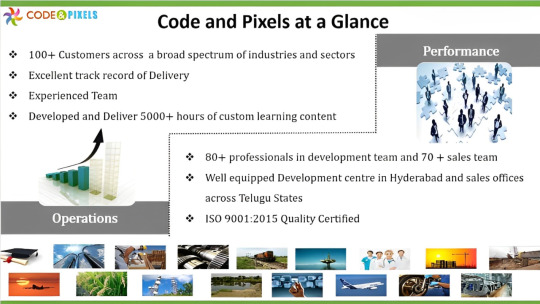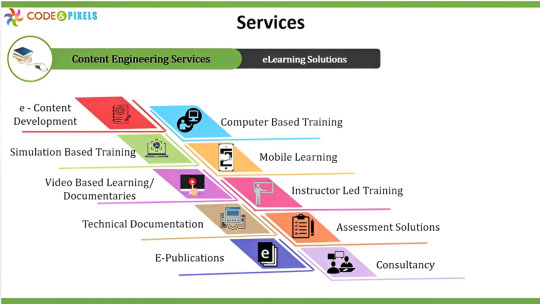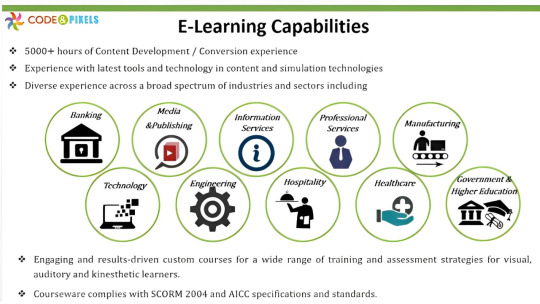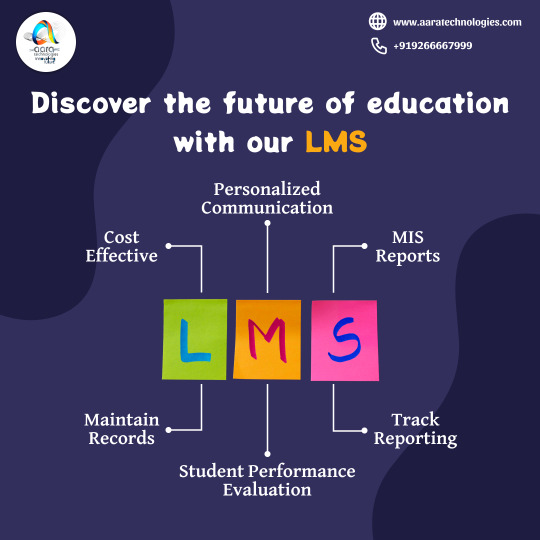#software development for learning management system
Explore tagged Tumblr posts
Text
Empowering the Future of Learning with Innovative Technology Solutions

Transform Education with Mobiloitte's Technology Solutions. From interactive e-learning platforms to personalized educational apps, we empower educators and students alike. Our innovative solutions enhance engagement, collaboration, and knowledge retention. Unlock the full potential of education with Mobiloitte. Stay ahead in the digital learning revolution.
#E-learning solutions#learning management system solutions#smart learning management system#Mobile learning solutions#IT solutions for Education#Digital learning solutions#software development for learning management system#AI-powered educational solutions
0 notes
Text
Best LMS in Oman
The demand for Learning Management Systems (LMS) is growing rapidly in Oman as businesses and educational institutions embrace digital transformation. An LMS streamlines the process of delivering, managing, and tracking online training and education. But with numerous options available, how do you choose the best LMS in Oman for your needs?
In this guide, we’ll explore the key features to look for in an LMS, the benefits of using one, and the top LMS solutions available in Oman.
What is an LMS?
A Learning Management System (LMS) is a software application designed to deliver, track, and manage educational or training programs. LMS platforms are widely used in schools, universities, and corporate training programs to ensure efficient learning and skill development.
Why Use an LMS in Oman?

With the rapid shift toward e-learning and remote work, an LMS provides a centralized platform to streamline education and training. Here’s why adopting an LMS in Oman is crucial:
Enhanced Accessibility: Learners can access content anytime, anywhere.
Cost-Effective: Reduces the need for physical classrooms and printed materials.
Improved Tracking: Offers detailed reports on learner progress and performance.
Scalability: Easily manage training for a growing workforce or student base.
Localization: Many LMS platforms offer Arabic language support, making them ideal for Oman’s audience.
Features to Look for in the Best LMS in Oman
When selecting an LMS, consider these essential features:
User-Friendly Interface: Easy navigation for both administrators and learners.
Mobile Compatibility: Access courses on smartphones and tablets.
Customization Options: Tailor the platform to fit your branding and requirements.
Multi-Language Support: Essential for catering to Oman's bilingual audience (Arabic and English).
Compliance and Certification: Ensure the LMS complies with industry standards and provides certifications.
Integration Capabilities: Seamlessly connect with other tools like HR software, CRMs, and video conferencing apps.
Top LMS Solutions in Oman
1. Moodle
Overview: An open-source platform popular for its flexibility and community support.
Why it’s great for Oman: Supports Arabic, customizable, and budget-friendly.
Best for: Educational institutions and small businesses.
2. Blackboard
Overview: A robust LMS ideal for universities and large organizations.
Why it’s great for Oman: Offers mobile compatibility and localized support.
Best for: Higher education and corporate training.
3. TalentLMS
Overview: A cloud-based LMS known for its ease of use and scalability.
Why it’s great for Oman: Offers Arabic language support and integration with third-party tools.
Best for: SMEs and fast-growing companies.
4. Docebo
Overview: AI-powered LMS designed to enhance learning experiences.
Why it’s great for Oman: Provides multilingual support and advanced analytics.
Best for: Large corporations and enterprises.
5. D2L Brightspace
Overview: A highly intuitive LMS focused on student engagement.
Why it’s great for Oman: Flexible features and excellent customer support.
Best for: Universities and K-12 schools.
Benefits of Implementing the Best LMS in Oman
Customized Learning Paths: Cater to individual learning needs with personalized content.
Increased Engagement: Interactive features like quizzes and gamification boost participation.
Performance Tracking: Monitor progress and make data-driven decisions.
Compliance Training: Ensure employees meet regulatory standards efficiently.
FAQs About the Best LMS in Oman
1. What is the cost of an LMS in Oman?
The cost varies depending on the LMS provider, features, and number of users. Free options like Moodle exist, but premium platforms can cost from OMR 500 to OMR 5,000 annually.
2. Can I get an LMS with Arabic support in Oman?
Yes, many LMS platforms, including Moodle, TalentLMS, and Blackboard, offer Arabic language support.
3. Which LMS is best for small businesses in Oman?
TalentLMS is an excellent choice for small businesses due to its affordability, scalability, and ease of use.
4. Do LMS platforms offer offline access?
Some LMS platforms, like Moodle, provide offline access to course materials via mobile apps.
5. How long does it take to implement an LMS?
Implementation time depends on the platform’s complexity and your organization’s requirements. It typically takes 2-8 weeks.
Conclusion
Choosing the best LMS in Oman can transform the way you deliver training and education. By focusing on features like localization, scalability, and user-friendliness, you can select an LMS that meets your organization's unique needs. Whether you’re a small business or a large university, the right LMS will empower your learners and drive success.
Ready to adopt the best LMS in Oman? Evaluate your needs and explore the options listed above to find your ideal solution!
#Best LMS company in Oman#Best LMS in Oman#Learning Management System#Talent Development Software#Best LMS Solutions#Best LMS Software 2025
0 notes
Text
How to Choose the Right Education Learning Management System for Your Institution
Anamika's Challenge with School Management
Meet Anamika, the head of a fast expanding K–12 institution. Her workload climbed significantly each new semester, and the complexity of running several departments also increased. From admissions and attendance to fee collecting, library administration, and exam scheduling—Anamika felt she was drowning in administrative chores.
Her staff depended on hand procedures that allowed for mistakes since student data was spread over several systems. She knew her institution needed a solution that would simplify these processes, but every learning management system (LMS) she looked at appeared either too costly, too complicated, or not fit for her university.
Anamika annoyance is not unusual; education institutions all around struggle with comparable administrative process management issues. Rising demand for automation in education systems is expected to push the global education LMS market to reach $25.2 billion by 2026, according to a Research and Markets analysis. Still, many find it difficult to choose the correct LMS solution in such a packed market.
A Global Issue in Management of Education
It is true that the challenge to effectively handle educational data is worldwide. The latest studies reveal that employing learning management systems around 60% of educational institutions claim notable time and cost reductions.
Even though new-age LMS like ISMEDU Software Solution INTELS is revolutionizing the way for the education industry worldwide, still a lot of colleges and universities rely on antiquated systems or manual procedures, which results in data silos, inefficiencies, and a dearth of real-time institutional performance analysis.
These inefficiencies plague teachers, administrators, and students all around. Knowing the key characteristics of an LSM becomes crucial to prevent expensive errors as organizations all around try to migrate toward digital platforms. Here's some guidance on things to search for in choosing the correct LMS for your company.
Important Factors to Guide Selection of the Correct Education LMS
1. Specify the Special Needs of Your Education Institution
Every institution has a different culture and structure, and so does its LMS demand. Clearly state the main problems you want to address before investigating the ideal learning management system.
Look for things like:
Is there a way you might effectively control enrollment and admission?
Are you mostly interested in automating payroll and fee collection in finance?
How important are scholarly elements such as grading, reporting, and curriculum planning?
This needs-based strategy guarantees that the LMS you choose complements the objectives and mission of your educational institution, therefore improving output in areas of most importance.
2. Review Core Features and Customizing Choices
Though not all of the characteristics of a learning management system will be applicable to every institution, they offer a broad spectrum. These elements should help you to think through:
Tracking student enrollment, attendance, grades, and behavior comes mostly from a central dashboard in student information management.
Automate payroll, billing, fees collecting, budget tracking in financial management.
Curriculum and Academic Management: Tracking academic performance, class scheduling, course management.
Channels of flawless communication between parents, instructors, and students help to foster involvement.
Furthermore, look for a learning management system with customizable choices so you may add modules as your university expands or change features. Flexibility guarantees that the LMS may change to meet changing requirements of your company.
3. User-Friendly Interface
Only if your staff, teachers, admin and other stakeholders can use LMS effectively will it be most powerful.
Test end users to assess the usability of the product when assessing solutions. It should be easy for administrators, educators and even children who will be interacting with the system.
4. Integration Capabilities
Many organizations already make use of several software programs for varied purposes, like HR systems, finance systems, or library administration. Reducing data silos and guaranteeing a consistent experience across departments depend on selecting an LMS that can easily interact with various technologies and easily integrate within your institution’s system.
5. Reliable Training and Customer Support
Learning management system provider’s post-implementation support could either make or ruin the experience.
To handle any technical problems, go for providers that provide complete onboarding, continuous training courses, and 24-hour customer service. (24-hour availability? Who does that? Read till the end)
A well-supported learning management system guarantees that, even in difficult circumstances, your institution can keep running without hiccups.
Learn more..
#custom software development company#custom software development#task management software#ai web development#erp software#ai powered solutions#lms software#learning management system
0 notes
Text
On-demand and Customized Learning Management System
Tecnolynx designs adaptive learning pathways through a personalized, reliable, and user-friendly learning management system (LMS) platform. Our skilled developers excel in creating custom LMS solutions, handling integration, and overseeing implementation, all tailored to fit your unique learning requirements.
Looking for a powerful LMS solution? Connect with Tecnolynx for a customized and robust learning management system tailored to your needs.
#Learning Management System (LMS)#eLearning solutions#LMS development#Customized eLearning platforms#Online training software#Virtual learning environments#Educational technology solutions#Learning content management system (LCMS)#Interactive learning experiences#Personalized learning platforms
0 notes
Text
#learning management software in chennai#LMs software in chennai#LMS system development services in chennai
0 notes
Text
8 Common pitfalls when implementing learning management software
Implementing Learning Management Software (LMS) can revolutionize how an organization manages training and education. However, many organizations face common pitfalls during the implementation process that can undermine the effectiveness of the LMS. Understanding these pitfalls and planning accordingly can help ensure a smoother transition and better outcomes. Here are some common challenges and a checklist to help avoid them:
1. Inadequate Needs Analysis
Pitfall: Failing to thoroughly analyze the organization’s needs and objectives before selecting an LMS can lead to a poor fit.
Checklist:
Identify specific training needs and goals
Engage stakeholders from various departments
Assess existing systems and content
2. Lack of User Involvement
Pitfall: Not involving end-users (e.g., employees, instructors) in the selection and implementation process can lead to resistance and underutilization.
Checklist:
Gather feedback from potential users
Include users in testing phases
Provide training and support for all users
3. Insufficient Training and Support
Pitfall: Neglecting to provide adequate training and ongoing support can result in poor adoption and effective use of the LMS.
Checklist:
Develop comprehensive training materials
Offer initial and refresher training sessions
Set up a helpdesk or support team
4. Poor Integration with Existing Systems
Pitfall: Failing to ensure that the LMS integrates seamlessly with existing systems (e.g., HR software, content management systems) can lead to data silos and inefficiencies.
Checklist:
Evaluate integration capabilities of the LMS
Plan for data migration and system compatibility
Test integration thoroughly before full deployment
5. Ignoring Scalability and Flexibility
Pitfall: Choosing an LMS that doesn’t scale or adapt to changing needs can limit future growth and flexibility.
Checklist:
Assess the scalability of the LMS
Ensure it supports a range of learning formats
Review the vendor’s update and support policies
6. Overlooking Data Security and Compliance
Pitfall: Failing to address data security and compliance issues can lead to breaches and legal problems.
Checklist:
Verify the LMS complies with relevant regulations (e.g., GDPR, FERPA)
Implement robust security measures
Regularly review and update security protocols
7. Inadequate Evaluation and Feedback Mechanisms
Pitfall: Not having a system in place to evaluate the effectiveness of the LMS and gather feedback can result in missed opportunities for improvement.
Checklist:
Establish metrics for evaluating LMS success
Collect feedback from users regularly
Make adjustments based on feedback and performance data
8. Unrealistic Expectations and Goals
Pitfall: Setting unrealistic expectations for the LMS’s capabilities and benefits can lead to disappointment and dissatisfaction.
Checklist:
Set clear, achievable goals for the LMS implementation
Communicate expectations clearly to all stakeholders
Monitor progress and adjust goals as needed
By addressing these common pitfalls effectively, organizations can maximize the benefits of LMS, ensuring a successful implementation that drives learning and development outcomes.
#LMS implementation#LMS#Learning management software#content management systems#elearning solutions#custom elearning development services#elearning platform
1 note
·
View note
Text
AI and Machine Learning Are Shaping Fleet Management Software | SSTech System

AI and machine learning are rapidly transforming fleet management software, revolutionizing how fleets are managed in logistics and transportation.
Thus, using these technologies, the fleets’ managers can increase efficiency, decrease expenses, and implement safety measures innovatively. It is essential to understand what constitutes fleet AI, how the application powers fleets, and the transformation benefits it affords FMS.
What is fleet AI?
Fleet AI is a system that uses AI and machine learning in the executive of vehicle fleets. This technology involves applying data analytics on various aspects of the fleet and using prediction models and decision-making tools to improve these aspects.
Talking more about AI in fleet management, the following options are essential fleet route optimization that helps improve the daily route spending and, based on that, carries out effective and efficient work. Predictive maintenance will help minimize the risks and costs associated with vehicle breakdowns and maintenance.
How is AI used in fleet management Software?
AI and machine learning are utilized in fleet management in several key areas:
Route optimization
Current technologies such as artificial intelligence implement real-time data information systems and predictive analysis when determining routes accordingly Al in fleet management systems. These systems use traffic flow patterns, weather forecasts, and other past information to alert drivers to the most effective roads and fuel-efficient methods.
Predictive maintenance
Machine learning in fleet management is used to diagnose potential faults in vehicles, depending on the analysis of performance data. Since these machines are costly to repair, this proactive approach minimizes the breakdown time of the machinery while at the same time making the required maintenance in advance, thus cutting on cost.
Driver behavior monitoring
Real-time data captured using AI in fleet management systems can reveal information about driving style, including hard braking or nail acceleration. It helps train seasoned and new drivers, enhance road safety, and alleviate frequent breakdowns of transport facilities.
Fuel management
AI and machine learning can optimize fuel consumption by analyzing data from various sources. They help identify efficient routes, monitor fuel usage, and detect irregularities like theft or wastage.
Automated reporting and compliance
Automotive industry and logistics professionals can save time, report compliance, and automate the process using AI-powered fleet management software. This saves time when manually compiling documents for the fleet managers and also provides accurate records and information.
Advantages of AI and ML in FM software solutions

The integration of AI and ML in fleet management software offers numerous benefits that enhance the efficiency and effectiveness of fleet operations:
Improved efficiency
AI and machine learning help different aspects of fleet management, from planning and implementing the most efficient routes to scheduling the times for vehicle maintenance. This leads to an enhancement in costs since healthcare resources are utilized optimally and efficiently.
Enhanced safety
Fleet analytics enables real-time analysis of driving behavior and vehicle performance, helping detect potentially hazardous conditions and minimize accident risk. This enhances monitoring and maintains high safety standards.
Cost Reduction
Reduced operating costs are some of the benefits that come with the use of AI in fleet management platforms, such as predictive maintenance and efficient fuel consumption. These include a bit of downtime and increased fuel consumption because when a manager reduces these aspects, they cut costs significantly.
Better decision making
AI in fleet management involves using technology to determine fleet managers’ decisions, given past data about a fleet’s performance. Data analysis lets managers be informed while making decisions on any aspect concerning the total fleet.
Scalability
The current generation of fleet management software often integrates artificial intelligence and machine learning, making the software solution very scalable. These systems offer flexibility regarding fleet size. They can scale easily, allowing the business to grow without needing to overhaul the existing systems.
AI in supply chain and logistics
Artificial intelligence in logistics and supply chain management has also changed the overall logistics field. When the supply chain is managed through artificial fleet management systems powered by artificial intelligence, it is much easier for companies to understand how the different parts of the supply chain network are performing.
SSTech system solutions and AI development services
Firms like SSTech System Solutions are well-positioned to offer the AI development services needed to strengthen fleet management and logistics. These services include designing and implementing tailor-made fleet management platforms suitable for the business, regardless of size, from a one-man business to a vast logistics company.
Mobile application development for fleet management
The advent of mobile applications and optimizing their use in managing vehicles has also added to the technological advancement of AI in fleet management systems. These applications offer open access to actionable data, allowing fleet managers to make decisions on the move.
Fleet management software of the modern type is being supported and developed by various companies that mainly focus on Android app development and iOS Application Development and can offer new products that perfectly fit the existing strategies.
Data analytics in fleet management
One can also discuss the importance of data analytics in fleet management and how it is crucial. Asynchronous methods like AI and machine learning help analyze large datasets to improve fleet management. Data analytics plays a crucial role in AI-driven fleet services, identifying trends and forecasting outcomes.
Fleet Management solutions and modern fleet management software
Modern fleet management software using artificial intelligence technology is transforming the logistics sector. New-generation software products provide a solution set to perform all operational activities of fleet management. They offer all the solutions required to operate fleets practically and legally, from route optimization to compliance.
Conclusion
Applying AI and machine learning to manage fleets has extended its benefits into fleet management software. With these technologies, fleet managers can optimize the various aspects of operations, such as efficiency, protection, and cost reduction.
In the logistics industry, it’s crucial to assess how AI-based fleet management systems can enhance efficiency and competitiveness. AI development, mobile app development, and data analytics are key to advancing fleet management with AI and machine learning.
#mobile app development#sstech system#webdevelopment#appdevelopment#b2b#business#flutter#itsolutions#india#appsdevelopment#sstechsystem#Android app development#AI development services#machine learning#AI development#fleet management systems#transforming fleet management software#logistics solution#australia#usa#it consulting
1 note
·
View note
Text
Guide: How to Build a Learning Management System (LMS) | Syndell
Learn how to build a learning management system (LMS) with Syndell's comprehensive guide. Discover LMS software development services and costs. Contact us for expert assistance from a leading LMS development company.
#lms software development services#lms development company#how to create a learning management system#develop learning management system#how to develop a learning management system#create your own lms#lms software development#how to build a learning management system
1 note
·
View note
Text
#artificial intelligence#branding#digital marketing#google ads#programming#python#machine learning#linux#marketing#online marketing#erp software#erp solution#erp systems#cloud erp#erp#inventory management#software development#software#web development#web design#old web#website
0 notes
Text

Revolutionise Education with Ficode's Software Development Services
Experience the future of learning with Ficode's top-notch software development services. Our expertise extends to EdTech, where we craft innovative solutions to enhance educational experiences. From interactive learning platforms to intuitive management systems, Ficode's commitment to excellence shines in every line of code.
Elevate your EdTech venture with our seamless software development services. Trust Ficode to bring your educational vision to life with cutting-edge technology and unparalleled expertise. Empower education with Ficode – Your Partner in EdTech Evolution.
#Bespoke software development company#Bespoke software company#Edtech Software Development#Learning Management System#ficode#ficode technologies
0 notes
Text
Welcome to school software, your all-in-one solution for managing and enhancing your school’s administrative tasks and academic processes. Our comprehensive school software offers a range of powerful features designed to streamline your school’s academic and administrative operations, promote collaboration, and improve efficiency for administrators, teachers, students, and parents.
#school erp software#school solution#best school software#school management system#student management system#student management#learning management system#lms development#erp software
0 notes
Text
LMS for Culinary Arts: A Modern Recipe for Teaching Cooking Online

Cooking is not just an age-old craft but an art form that has been passed down through generations. From grandma's secret recipes to culinary schools' structured courses, the transition of knowledge has mostly been hands-on. However, the digital age, fueled by the advancements of Learning Management Systems (LMS), has made it possible to teach culinary arts online, making global cuisine accessible from the comfort of one's kitchen. Let's simmer down into the world of online culinary education and see how LMS platforms are revolutionizing the way we learn to cook. Tap here: http://imagin4u.blogaholic.se/2023/sep/185847/lms-for-culinary-arts-a-modern-recipe-for-teaching-cooking-online/
#lms for culinary arts#elearning#lms for business#learning management system#lms#lms for colleges#lms development#lms for university#lms system#corporate lms#lms login#lms software#bestlms#lms for corporate
0 notes
Text
0 notes
Text
E-learning content Development Company in Hyderabad Code and Pixels
E-Content development
At Code and Pixels, we believe that great training begins with great content.
Code and Pixels provides customised and current learning content that makes you stay competitive — right from knowledge transfer of company processes and systems to product information. Such technically heavy and complex content becomes a challenge for the trainer to deliver and difficult for end users to consume in conventional training formats. Hence,

We develop custom E-learning content which is:
Sound using instructional design principles and pedagogy
Compliant with international E-learning standards
A combination of multiple media — games, quizzes, tests, simulations, video, animation, audio and graphics.
Compatible and runs on any standard Learning Management System (LMS)
Highly interactive and enables tracking and scoring of each learner’s progress
Multilingual
We employ a multitude of technologies and tools like graphics, animations, audio-visuals, interactive games and activities that help in giving the right information in the right manner to the right audience.
Mobile Learning/HTML 5
We are living in a multi-device world. We now have options to deliver eLearning using a wide variety of devices such as desktops, laptops, tablets and smart phones. Whether it is for smart phones or tablets — using platforms like Android, BlackBerry or iOS– we develop any kind of solution which suits your mobile learning needs perfectly.

What Is HTML5?
HTML5 is the newest hyper text markup language for websites from the World Wide Web Consortium (W3C). The first draft was made public in 2008, but not much happened until 2011. In 2011, HTML5 was released and people started writing about it and using it, but the support in different browsers was still poor. Today all major browsers (Chrome, Safari, Firefox, Opera, IE) offer HTML5 support, therefore the newest HTML technology can be used at its best today.
Major browsers
IE9+, FF4+, Safari5+, Opera11+, Chrome10+, Blackberry Browser, Silk
Platforms
iOS, Android, ChromeOS, BlackberryOS, Symbian, Windows Mobile 7.5+
Libraries
Webkit (Google, Apple, etc.), Gecko (Mozilla), Trident (Microsoft), Presto (Opera)
A reality indeed. As HTML5’s impact continues to ripple, many companies are dealing with the necessity of abandoning Flash applications. HTML5 is more flexible, allows movement, doesn’t affect SEO and doesn’t need a plug-in.

The migration of Flash eLearning courses to HTML5
eLearning, Training, Media organizations andmarketing departments of all kinds of companies have huge volumes of Interactive Flash content that has traditionally been consumed on desktops. With the rapid proliferation of smart phones and tablets, enterprises are faced with the prospect of their existing content becoming obsolete, since popular mobile platforms don’t support Interactive Flash.
While new content can be developed on a platform an industry standard format like HTML5, ground-up redevelopment of existing Interactive Flash content for mobile devices is not an option for most enterprises. What they need is a high-quality yet rapid solution for migrating their legacy of Interactive Flash content to HTML5.
Flash to HTML5 Migration
We shall take your existing Interactive Flash content and use the Flash to HTML Framework to re-purpose it to make it usable and HTML5 content that is suitable for a variety of devices including desktops, smart phones & tablets.
Powered by HTML5, CSS3 and JavaScript, our Flash to HTML5 framework enables us to accelerate speed-to-market for the new HTML5 content while preserving the richness of the original Flash content.
The new HTML5 content is able to fulfill the greater demands on usability posed by the varying screen sizes and resolutions of mobile devices. Recognizing that mobile devices don’t always have the same processing horsepower of desktops, our migration/conversion process leverages our framework to ensure that the repurposed HTML5 can perform on the most popular mobile platforms.
The framework adheres to content standards and supports various fundamental interactive behaviors like programmed workflows, directional information, enhanced content Menus, Multimedia Content Delivering, 2D Animations, Voice Synchronization, Interactivity, Status Bar, Volume Controllers, Slide Bar, Bookmark, Search, Standard navigation features i.e. Next, Previous, Menu amongst several others
With mobile devices being used and preferred for numerous multimedia applications, we shouldn’t forget something that Apple first pointed out. Flash does use too much processing and battery power; something that makes it disadvantageous. So migration to HTML becomes unavoidable.
In a continuously changing and fast paced environment, we can’t chain users to their desks and offices. So the creation of HTML5 eLearning applications, training material, presentations etc. or the conversion of Flash to HTML for mobile devices has become inevitable.
#E-learning#E-learning software#E-learning standards#Learning Management System#eLearning applications#ietm#ietm code and pixels ietm hyderabad#code and pixels#ietm developement#ietm level iv#elearning#ietm software#ietm level 4#technology#software#paradisosolution#mmgen2
1 note
·
View note
Text
LMS Integration Strategies: Connecting with Other Systems for Enhanced Functionality
In today's dynamic learning landscape, the role of Learning Management Systems Development (LMS) goes beyond the traditional confines of course delivery. To provide a holistic and seamless learning experience, LMS integration with other systems has become a strategic imperative for organizations. This integration goes beyond the standard functionalities of an LMS, enabling the creation of a unified learning ecosystem that boosts efficiency, engagement, and outcomes.
At the heart of this transformation lies the concept of connecting the LMS with key systems like Customer Relationship Management (CRM), Human Resources (HR), and content creation platforms. In this blog, we'll delve into the benefits of these LMS integration strategies and how they contribute to the success of organizations. We'll also explore the role of a proficient LMS development company in orchestrating these integrations.
Understanding LMS Integration: Building Bridges for Better Learning
LMS integration involves the seamless connection between your learning management system and other critical systems within your organization. The aim is to foster a cohesive environment where information flows effortlessly, enabling enhanced functionality, improved data insights, and a unified learning experience.
Benefits of LMS Integration: Unlocking Synergy
Enhanced User Experience: By integrating the LMS with CRM and HR systems, you can provide learners with a personalized experience. Learner profiles can be enriched with data from the CRM, tailoring learning paths to individual needs. Moreover, HR integration ensures that training aligns with employee skills and career progression.
Efficient Training Management: Integration with HR systems allows for seamless employee onboarding and offboarding. Training assignments can be automated based on roles and responsibilities, ensuring that new hires are equipped with the knowledge they need.
Data-Driven Decision Making: Integrating LMS with CRM and HR systems generates valuable data insights. These insights can inform training strategies, enabling organizations to focus on areas that contribute to business growth and employee development.
Unified Reporting: When data from CRM, HR, and LMS systems converge, reporting becomes more comprehensive and accurate. Performance analytics provide a holistic view of learner progress, making it easier to identify trends and areas for improvement.
Streamlined Content Management: Integration with content creation platforms streamlines the delivery of up-to-date content. Changes made in the content platform can reflect directly in the LMS, ensuring learners have access to the latest materials.
Smoother Administration: Integrating systems reduces administrative overhead. For example, user data changes in the HR system can automatically update in the LMS, eliminating manual updates and reducing the risk of errors.
The Role of an Expert LMS Development Company: Crafting Seamless Integrations
For organizations looking to capitalize on the benefits of LMS integration, partnering with a proficient LMS development company is paramount. These experts understand the intricacies of developing and integrating LMS solutions that align with your organization's unique needs.
A skilled LMS development company employs a systematic approach to integration, considering factors such as data security, compatibility, and scalability. They collaborate with your team to map out integration points, develop APIs, and ensure that data flows seamlessly between systems.
In conclusion, LMS integration strategies that involve connecting with CRM, HR, and content creation platforms can create a unified learning ecosystem that transforms the way organizations educate and engage learners. With the guidance of an experienced LMS development company, this integration can unlock synergies, streamline operations, and provide data-driven insights that drive success. As businesses strive for efficiency and adaptability, an integrated LMS becomes a cornerstone of their growth journey in the realm of learning and development.
Related:
Understanding LMS Pricing: A Comprehensive Guide to Custom Development and SaaS Costs
#lms development company#learning management system development services#learning management system#learning management system development#software solutions#development#lms
0 notes
Photo

Aara Technologies is a leading LMS development company that specializes in the development of custom LMS solutions. We have a team of experienced LMS developers who can help you create an LMS that meets your specific needs.
#software development company#development company#learning management system#learning management system software
0 notes